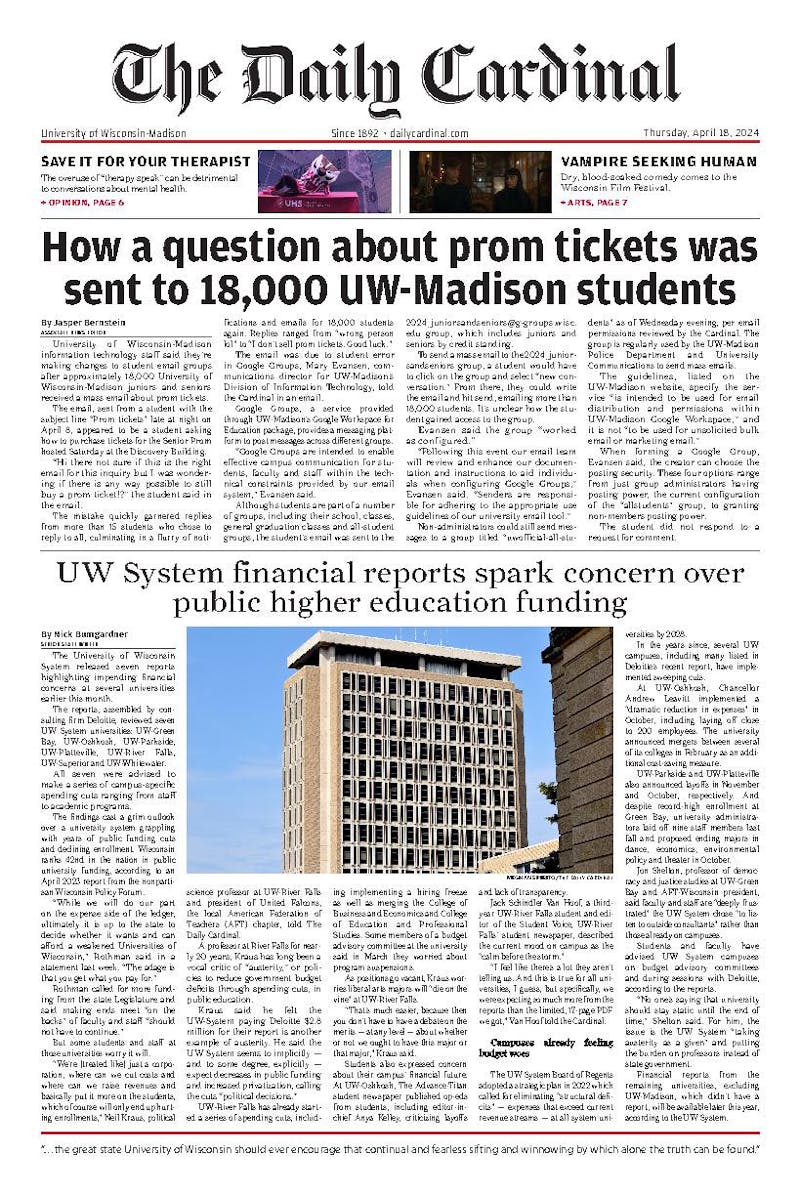Yesterday, this page featured an opinion column by veteran contributor Steven Nemcek. Steven very carefully dissected what he saw as failures in how the concept of white privilege is defined and taught to students. I purposefully avoid reiterating his points in this rebuttal as Steven is much better at explaining his position than I am.
The problem with his attack on white privilege is a lack of perspective. Race in American culture is a unique phenomenon, it cannot be understood in bits and pieces so it must be approached in its entirety. Trying to understand race is complicated further because the discussion around race is a metaphor-free space. Comparing race to gender, disability, sexuality, hair-color, class or using a Mac vs. a PC is inadequate and reduces the issue. Because trying to tackle race in contemporary America at a sociological level is more appropriate for a Ph.D thesis than an opinion column, I’m going to try to start with some of my perspective on race, and white privilege.
There was a time in my life I didn’t think about race much in terms of how it affected my life. This changed when I was 13, on vacation in the South. I was walking around loving life and listening to Maroon 5 or whatever I was into back then and someone yelled out to me “go back to Mexico!” My response—probably something about being Ecuadorian, not Mexican—got caught in my throat and I lowered my head and kept walking. I realized then, the friendly chiding that my friends doled out by calling me “Mexican” or “Beaner” (we’re still friends, the chiding went both ways I assure you) came from a place that might not be so friendly.
I am not exaggerating when I say that having some random hick tell me to go back to Mexico changed my life. If the incident hadn’t happened that day, it surely would’ve happened soon after. If anything, I am extremely lucky to have gone 13 years without trying to contextualize the massive institution of race with my life experience. Since then I have experienced racism in a variety of ways and contexts. Most of it is benign and easy to shed, some of it is not. My sense of humor has absorbed all the times I’ve been mistaken for a service employee or waiter. I eventually laughed off being ignored at a Lexus dealership when I tried to get my second-hand Lexus serviced. It was harder to laugh off the presumption that I was only accepted into UW-Madison because of my race. It turns out, being one half of a mixed-race couple in rural Wisconsin can still draw a lot of long glances. These glances, eventually glares, still bug me in a way I can’t understand. I could keep going, for a really long time, but I’ll stop here and point out that I live a racialized life because of racism and racists, not because of my ethnicity.
Back to yesterday’s column. First, I’ll go through the statistics that my colleague Steven uses, then approach white privilege in general. Steven uses the fact that non-white individuals are overrepresented in federal employment as an excuse to declare racism over and all of the goals of the civil rights movement accomplished. Unfortunately, being a post-office worker or sweeping the floors at the Pentagon aren’t jobs that carry much institutional power. A better measure might be political positions; however, we must examine the whole issue of race not just the statistics. If one were to look at a map of the United States according to non-white percentage of the population, the South would look totally different from the mid-West, which would look totally different from the West Coast, because each region, each state, has its own unique set of racial politics based on ratios and local history. Looking at statistics of racial minorities in government representation without taking into account community makeup is weak rhetoric.
The second figure that Steven leans on is median household income by racial makeup, pointing out that Asian households make a whopping $75,027 as compared to the white household average of $62,525. What Steven neglects to do is go back and examine the overall representation figures, where he himself notes that roughly 5 percent of the U.S. population is Asian. Factors like immigration patterns, schooling and cultural influences can be strong enough within the small Asian-American community to push their median income above the white average. Does this income figure mean that Asian individuals are actually at the top of the racial food chain? Hell no! This is just a small statistic in a sea of available figures surrounding race in America. Asian-Americans have their own history of being illegally incarcerated, openly despised and more recently, fetishized and commodified.
The figures that Steven bases his entire argument around are weak and not indicative of any greater truth other than a basic misunderstanding of how race functions in America. Which leads me back to white privilege. Steven took issue with some of the examples used in an educational poster he saw which promoted the idea of white privilege. I think the poster’s quotes are perfectly accurate. Steven saw these posters not as an educational tool, but as a re-imagining of America, which is not what the posters were meant to elicit. One of the examples reads “Most of my teachers looked like people of my race.” Having teachers of your own race can be beneficial surely, but is really not necessary outside of an openly-racist society. But here is my situation: I have never had a teacher of my own race. I was taught Spanish in grade-school by teachers who had a worse grasp on the language than I did (in high school, I took German, but most of the Spanish teachers there were white too). What if I wanted to talk to someone about the issues I had contextualizing my race? The poster also lists “stories in the media about people from my racial group are mostly told by people from my racial group” as a white privilege. Readers, I ask you, name one Hispanic or Latino actor in my age group celebrated by his peers. Name one popular movie or TV show that features a race or immigration storyline that I could identify with. You ask, why is this important? It is important because the depictions of my race, and the popular definition of what it means to be 22 and Hispanic are controlled by people who don’t think about race everyday. It means when I watch TV and find no one that looks like me, it is impossible for me to imagine myself within a metric (for example, attractiveness) which is applied exclusively to people who don’t look like me.
So, what is white privilege? White privilege is seeing a poster explaining white privilege, which in case you didn’t notice, is for white people, and demanding its removal. White privilege is not understanding that every non-white individual in America knows what white privilege is, even if they don’t know the name for it. White privilege is looking at a few paltry statistics, declaring racial injustice over and leaving the free market to sort out any remaining issues. The truth is, we are approaching a post-racial society, but we aren’t even close yet. There is veiled racism everywhere, but unless you’ve been trained to look for it—either through academics, or some hick’s dumb remark a decade ago—it’ll pass right over you. And ultimately, this ability to pass right under racial dialogue if you want, that is the real white privilege. A color-blind society already exists, but it has no racial minorities in its ranks.
What do you think about racism and white privilege in America? Do you have any ideas on how to eliminate discrimination? Please send all feedback to opinion@dailycardinal.com.





